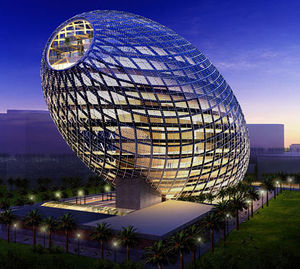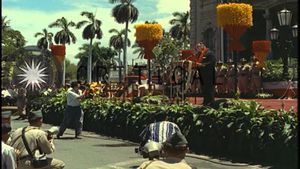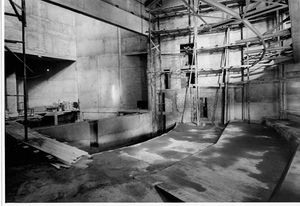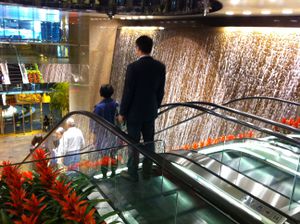Stoddard Education Building

"The Egg", as the Stoddard Education Building is commonly referred to, is a 30 storey building in the central district of Bellissimomare, the capital city of Sayaffallah. Upon its completion in 1952 the building was an iconic feature in the central district and provided a regular backdrop for photos of visiting tourists. In 1961 the building underwent extensive renovations and had the entire outside of the building redone in glass providing dramatic views within the building for those who worked there. In 1972 the building was renovated again the most extensive time in its history with a hydraulic system installed allowing the central meeting floor at the top to be able to move up to the rooftop level with a retractable roof allowing meetings to be conducted in the sunshine or the ability for it to go all the way down to the basement level for meetings requiring privacy. To this day the Stoddard Building is a landmark within the capital city and was awarded the Iconic Architecture Award by the Parliament in 2002.
History
Concept and planning commission
Prior to the construction of the Stoddard Building the Council of Educators met in the Parliament Building regularly which shared space with the National Educational Authority as well as staffers from both entities. The space for both the parliament and the educational clients was simply not adequate so a planning commission purchased a segment of land in the center of the capital and hired the architect Ismail Parker to come up with conceptual designs for the building. The initial conceptual designs were deemed to be too phallic in nature to be an appropriate space for the Council of Educators to meet in. So the conceptual design process continued and by 1949 the egg shaped design was unanimously approved and the commission hired the Midtown Sufiya Company to carry out the process of construction.
Construction began after the necessary permits were granted by the Royal Council and the site was cleared, however during the clearing process for the site an ancient burial ground was excavated on the site prompting the permits to be revoked. Archaeologists carefully conducted a dig on the site finding evidence that the site once served as a burial ground for the cities poorest residents thousands of years ago. In a decision that to this day is still controversial the Sultan overrode the archaeologists and ordered that the remains be removed and placed in a warehouse for cataloguing and study and future placement in a museum setting. This decision prompted a great outcry but the Sultan did not relent and instead sent in the military troops to quell the street protests and return the citizens to their homes. This rare show of force worked and caused the commotion to die down and the city to return to its normal functioning. However to this day the incident is still talked about in hushed tones as a time in which the Sultan did wrong by the people.
By the year 1949 came to a close construction was well underway with foundations laid and support beams already going up. By mid 1950 scaffolding could be seen dotting the construction site and the progress was accelerated as the construction company was aided by military engineers who came in to assist the project to get it running at a more faster pace. As a cause of this direct help by the military engineers the cost for the construction was absorbed by 50% by the government as a way of evening out the expenditure so that it would not be an undue burden on the construction company.
Grand opening

On June 2, 1952 the Stoddard Building was officially opened in a grand ceremony featuring a grand prix race held on the outskirt of the site and a flyover by military aircraft. The building began its public operations on October 3, 1952 after a lengthy period of open house for the general public to come and tour the new facilities and to see a glimpse into the often closed door world of the Council of Educators.
The moving in process involved great numbers of trucks transferring items from the Parliament buildings to the newly opened Stoddard building and became the source of great frustration for those making their daily commute into the city. The traffic debacle became even more pronounced after the city mayor closed the routes to the Stoddard trucks during the key rush hours in order to prevent gridlock from developing in the city itself. The mayor defied orders from the parliament to lift the closures and instead cited that it is in the best interests of the nation and the city to have happy commuters rather than angry ones. And that is what it was, no challenge was given to the closures after that point and the mayor ended up as a local hero for his defiance.
A private opening was held on October 3, 1952 signifiying the moment that the COE would be able to take up their regular duties in the new building. The ceremony record indicates that the Sultan was not in attendance but that every member of parliament was in attendance for the private opening as well as all members of the existing COE at the time.
1961 renovations

By December 1, 1961 it was apparent that the building was needing renovations to correct problems that had arisen during usage in the first ten years. The central heating and air system was inadequate for the scale and scope of the building resulting in many cold corridors during the snowy winters that are typical within the capital city. In addition to this it was found during a structural fire in 1960 that the building did not have the correct wiring in place for its fire and emergency evacuation system resulting in alarms that either failed to activate with smoke causation or alarms that failed to indicate the area in which the fire was presently at. Fortunately the structural fire was identified and located in the kitchen area thanks to the prompt response of first responders. However the report by the fire marshal indicated that the building would have been a total loss had it not been for the response time of first responders. This report by the fire marshal became the impetus needed to prompt major structural renovations the following year in 1961.
The same architect was consulted for the renovations but due to existing commitments declined to participate in renovations in 1961 citing instead availability in 1965. Due to the severity of the changes needed it was decided by the planning commission to hire a new architect and several renovation companies to get the work done efficiently and quickly. 1961 saw the addition of a central plaza outside of the building where workers could congregate in the event of an emergency and also the addition of a museum explaining the work and role of COE as well as the educational system in Sayaffallah. Renovations also included installation of a brand new emergency alert system and the construction of a building monitoring station within the central lobby and connection to an outside monitoring facility located within the parliament building to provide two layers of response in the event of an alarm triggering within the complex.
Renovations began on December 10, 1961 and continued through March 5, 1962 when the formal building inspection was conducted by the original architect and the supervising architect as well as the government inspection teams responsible for ensuring structural integrity. During the inspection it was found that the wiring had been overloaded creating a potential fire hazard, because of this the wiring was stripped out of much of the building prompting the COE to be temporarily relocated to the parliamentary buildings they had vacated a little more than a decade prior. The reinstallation of wiring grids was done utilizing a thread link method in which the wiring was cased within sufficient level of insulation so as to reduce the chance of short circuiting or arcing of the wiring during an electrical event. In addition to these safety precautions the wiring was also equipped with monitoring links every 10 feet so as to ensure that maintenance personnel could adequately see where problems arose during a potential electrical event. These changes proved satisfactory during the June 17, 1962 inspection and the building was deemed to be at the excellent level of inspection rating. By August 1 the building was once again fully under use by COE.
1972 renovations


In 1972 COE petitioned Parliament to grant them a new renovation including changes to the layout and the structure of their building to promote greater workflow and connectivity among their colleagues and to house a greater number of staffers who were working at this time in an annex building 30 minutes away from the Stoddard. Parliament approved the request and stipulated that an architect be found by COE and commissioned as quickly as possible. By November of 1972 the renovations were underway and architects began their most ambitious changes yet to the Stoddard Building changing the way it looked entirely. The first step was the installation of glass paneling in replacement of the stainless steel exterior look, the stainless steel shell was dismantled section by section and replaced with custom fit glass paneling to provide a greater view out for those working inside. The next step was the complete transformation of the ground floor. The area directly underneath the conference room that COE met in was removed and a basement was created extending down for six levels after this was completed the area was walled off into a shaft for the conference room to be able to descend into the six level basement or to ascend through an installed retractable roof providing the conference room the ability to be outdoors if it so choose and on the roof if the weather was good. The lobby was relocated to a new area extending out from the Stoddard building with a 200 ft waterfall cascading down the side of it and escalators connecting to an upper lobby area in the original Stoddard Building.
The new lobby facility was in Stoddard 2 an add on building designed to create additional space for the workers at that time housed in an annex thirty minutes away. Building up from the extended lobby was office space for 3600 employees and executive conference rooms in the upper floors of the facility. Stoddard 2 was designed as a facility with multi purpose accessibility specifically that of greater workflow areas. The office plan layout in Stoddard 2 is much more open rather than the constricted cubicle and individual office space of Stoddard 1. Stoddard 2 was designed to have as much open air layout as well as could be possible. The roof of Stoddard 2 is entirely retractable and each floor is open to the next floor with a series of indoor balconies over an open air courtyard. The building is essentially designed in a circular shape and is directly behind the egg shaped Stoddard 1.
The renovations were formally completed in 1974 and a grand opening was held on December 1, 1974 with the Sultan and all of parliament in attendance for the grand opening ceremonies of the new building and the renovations of the main building. The building was heralded at its time as a revolutionary design and concept and has been copied through out the country as a design of what to do in architecture.
Interior design
The interior design of the facility was conducted by Aniyo Corporation and was designed originally to emulate a great forest with large fir trees placed throughout the original lobby to give the feeling of walking through a forest. In the 1972 renovation the theme was changed to that of a waterfall park with eight waterfalls each interconnected by a river system with four of the waterfalls being part of the outdoor plaza. The interior design concept was to create relaxation but yet contribute to increased productivity by the workforce inside.
The fixtures within the building incorporate gold leaf to accentuate the rich detail of the design that reflects the designs of the national flag of Sayaffallah. During the initial construction the interior fixtures were placed at fixed intervals within the corridors and hallways so as to increase light and airflow but also to promote a sense of elegance within the building. During the 1972 renovation many of the original fixtures were replaced with updated fixtures that remained true to the original. Many of these fixtures are still the same as the ones in the original edition of the building.
Security incidents
- 1986 a man and woman were found scaling the outside of the egg and were arrested on the roof for trespassing. Both individuals stated that they were wanting to take pictures for their wedding on the roof of the egg
- 1990 a copy cat of the 1986 event took place with a bride and groom in full wedding attire climbing the Stoddard to the top. Once on top the bride in full wedding dress crashed through the glass paneling of the retractable roof where the COE was meeting at the time and became impaled on a decorative spear in the center of the conference room. The groom filed suit but it was dismissed by the court due to a private settlement. After this incident the glass was replaced with strong and thicker glass on the retractable roof and fencing was installed around the easiest points of access onto the side of the Stoddard building.
- 1991 a man entered the lobby of COE with a bomb and threatened to set it off unless he was given a ransom of three large sacks of gold. The man was shot in the legs by a tactical sniper and was taken immediately into police custody.
The Conference Room
The Conference Room is the central room where COE meets under the retractable roof. The conference room is able to change the floor it is on and also able to rotate around the central axis of the building in a slow rotation. However the conference room cannot change floors and rotate at the same time. Its movement operation is controlled by a central engineer in the security monitoring station and can be changed by request of the COE at any time during its meeting. The table is a stainless steel table with a see through glass finish. In recent years it has been updated to a smart table in which the surface is effectively a screen that can be used by members of COE to see information and data in real time in front of them.
Each of the chairs of the conference room are biometric chairs that are able to monitor COE members vital signs while seated such as blood pressure rate, heart rate, blood sugar and stomach levels as well as indicators of health as they are needed. These signs are monitored by the security monitoring station which has a team of medical professionals in a special medical section to ensure that the COE members are well taken care of during their time in the conference room and building in general. Each of the chairs is able to be remotely operated by the individual sitting in it. Individual features can be adjusted on the chairs such as height, seat temperature, incline, movement. Even the color can be changed as the seat is covered in a special LED light cover which can adjust the color of the chair by the press of a button by the person sitting in it.
The Conference Room floor is a soft grey slate with a spongy padding underneath it and over sixty five million shock absorbing springs underneath the padding so as to absorb the movement of the room and to provide the absolute best in comfort for the COE members within the room at the time. The ceiling is a retractable glass ceiling with led glass panels able to be completely darkened or to change the color of the light that passes through it. The ceiling panels were installed in recent years and include over seventy five million LED light nodules throughout its entire segment. These LED light nodules can be controlled by the COE Chair person's console.